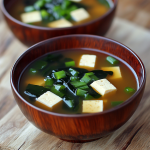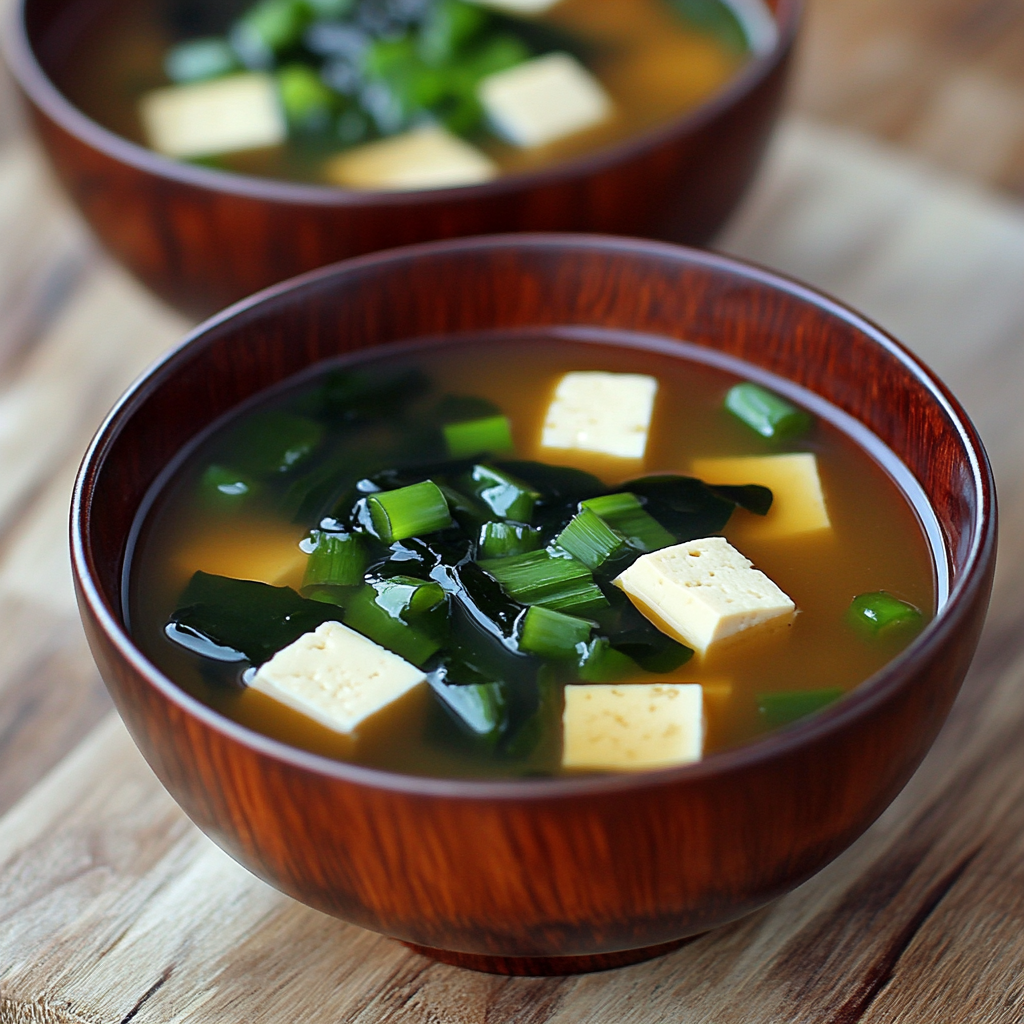There’s Magic in the Simplicity: Homemade Miso Soup
Hey there, friend! Olivia here, waving from my flour-dusted countertop. Can I tell you a secret? Some of life’s most profound comforts come in the simplest packages. Like that first sip of steaming homemade miso soup on a drizzly morning – it’s not just food, it’s a soul-hug. If you’ve ever felt intimidated by Japanese cooking, let this be your gateway. We’re ditching the salty restaurant versions for something pure, nourishing, and surprisingly easy. Imagine: delicate tofu floating like clouds, wakame unfurling like sea treasures, and that deep umami broth whispering stories of quiet Kyoto mornings. This isn’t about fancy techniques; it’s about honoring humble ingredients. Whether you’re thawing out after sledding or need a reset after a chaotic day, this bowl is your edible sanctuary. I’ll guide you through every step – no chef’s hat required, just an open heart and maybe my favorite chipped mug (it holds sentimental value and soy sauce stains). Ready to transform your kitchen into a zen den? Let’s make magic.
The Rainy Day That Started It All
Picture this: Kyoto, 2017. Rain lashed against our ryokan window like tiny drumsticks, and I was nursing major jet lag and a slight tempura overdose. My host mom, Emiko-san, silently placed a lacquered bowl before me. Steam curled upwards, carrying scents of the sea and earth. “Tadaima,” she smiled – “I’m home.” That first spoonful? Revelation. The silky tofu dissolved like a whisper, the wakame gave a gentle oceanic crunch, and the broth… oh, that broth! It wasn’t just warm; it felt like my bones were sighing. Emiko-san later showed me her dashi ritual – the careful kombu bath, the bonito snowstorm – with the reverence of a tea ceremony. Fast forward to my tiny Brooklyn apartment last winter. Grey slush coated everything, and I craved that Kyoto calm. Out came my stained kombu scrap, a bag of bonito flakes bought on a whim, and yes, a slightly-too-firm block of tofu. It wasn’t perfect, but that first sip? Instant transport. Now, every time rain taps my window, my kettle sings for dashi. Some soups feed the body. This one? It heals homesickness.
Your Miso Soup Toolkit: Simple Ingredients, Big Flavor
Don’t let the Japanese names scare you! Think of these as your flavor superheroes:
- Water (4 cups): The blank canvas! Filtered is best – chlorine fights subtle flavors. Chef’s tip: If using tap water, boil it first then cool slightly to evaporate chlorine.
- Kombu (1 piece, ~4×4 inches): This dried kelp is dashi’s gentle umami backbone. Looks like stiff leather? That’s magic waiting to happen! Sub: A pinch of MSG or 1 tsp soy sauce + 1/4 tsp sugar (but try real kombu once!). Find it in Asian markets or online.
- Katsuobushi (1 cup packed): Shaved smoked bonito flakes – the “smoky whisperer.” They look like pink wood shavings and smell intensely savory. Sub: 1-2 tsp dashi powder (hon-dashi) – reduce salt later!
- Soft/Silken Tofu (7 oz): The cloud in your bowl! Kinugoshi dofu melts on the tongue. Critical: NOT firm tofu! Silken is usually in shelf-stable boxes. Sub: Medium tofu if desperate, but handle like a soap bubble.
- Miso Paste (4 tbsp): The soul of the soup! White (shiro) miso is sweet & mellow (my Kyoto fave), red (aka) is punchier. Pro move: Use 2 tbsp white + 2 tbsp red for balance. Store in fridge!
- Dried Wakame (1 tbsp): Tiny, crinkly seaweed that blooms into emerald ribbons. Packed with minerals! Sub: A handful of fresh spinach added at the end (different, but green!).
- Green Onion (1 stalk): Fresh, green confetti! Adds bite and color. Sub: Thinly sliced chives or a pinch of onion powder in a pinch.
Crafting Your Broth Masterpiece: Step-by-Step
This isn’t a race – it’s a simmering meditation. Put on some soft jazz and breathe!
- Awaken the Kombu: Wipe your kombu lightly with a damp cloth (don’t scrub off the flavorful white stuff!). Place it in a pot with 4 cups cold water. Let it soak for 30 minutes – this gentle wake-up call extracts maximum umami without bitterness. Chef’s hack: Do this while prepping coffee! Multitasking magic.
- Heat With Love (No Boiling!): Place the pot over medium-low heat. Watch for tiny bubbles forming around the edges – we’re aiming for 140-160°F (60-70°C), NOT a rolling boil. Boiling makes kombu slimy and bitter! Takes 10-15 mins. Tip: Fish out the kombu JUST before it hits a simmer. Save it! You can chop it into salads or simmer it again for weaker dashi.
- Bonito Blizzard: Immediately after removing kombu, crank the heat to medium. When small bubbles rise (still not boiling!), shower in the katsuobushi. Let it dance for EXACTLY 30 seconds – then kill the heat! Overcooking = fishy sadness. Watch: The flakes will sink dramatically. So satisfying!
- Steep & Strain: Cover the pot and walk away for 5 minutes. Let those smoky flavors infuse like tea. Strain through a fine-mesh sieve lined with cheesecloth (or a coffee filter in desperation) into a clean bowl. Press gently – don’t squeeze or it turns bitter. Voila! Liquid gold (dashi). Save flakes for compost or furikake!
- Wakame’s Spa Moment: While dashi steeps, place wakame in a small bowl with cold water. In 5 minutes, it transforms into vibrant green ribbons! Drain and squeeze gently. Fun fact: It expands 10x! Don’t over-measure.
- Miso Marriage: Return dashi to a clean pot over medium-low heat. DO NOT BOIL – boiling murders miso’s delicate probiotics! Place miso paste in a fine-mesh strainer. Dip it into the warm dashi and stir/swirl with a spoon until fully dissolved. This avoids lumpy soup! Genius hack: Whisk miso with 1/4 cup warm dashi in a cup first, then pour it back in.
- Gentle Unification: Add drained wakame and cubed tofu. Stir lovingly with a wooden spoon (no whisking – protect that fragile tofu!). Heat for 2-3 minutes just until everything is warm. Key: Bubbles should barely kiss the surface. Patience = silky perfection.
The Art of Umami: Understanding the Science Behind Miso Soup
Miso soup is more than just a comforting bowl of warmth—it’s a masterclass in umami, the elusive “fifth taste” that makes food deeply satisfying. But what exactly makes this simple soup so magical? Let’s break down the science behind its rich, savory depth.
The Umami Power Trio: Kombu, Katsuobushi, and Miso
At the heart of miso soup lies dashi, the foundational broth that carries the essence of Japanese cuisine. Unlike Western stocks that rely on long-simmered bones, dashi extracts flavor through a delicate balance of two key ingredients:
-
Kombu (Dried Kelp) – This seaweed is packed with glutamic acid, a natural compound responsible for umami. When soaked in water, the kombu releases this amino acid, creating a subtle yet profound base. The trick? Never boil it—high heat makes kombu slimy and bitter.
-
Katsuobushi (Bonito Flakes) – These paper-thin shavings of smoked, fermented tuna add inosinate, another umami compound. When combined with kombu’s glutamates, they create a synergistic effect, amplifying the savory taste far beyond what each could achieve alone.
Then comes miso paste, the fermented soybean (and sometimes grain) condiment that ties everything together. Miso’s umami comes from enzymatic breakdown during fermentation, where proteins transform into amino acids. The longer the fermentation (as in red miso), the deeper the flavor.
The Magic of Fermentation
Miso isn’t just tasty—it’s alive! Traditional miso is a probiotic powerhouse, teeming with beneficial bacteria that aid digestion and gut health. This is why boiling miso is a cardinal sin—high heat kills those delicate microbes. Instead, we dissolve it gently in warm broth, preserving both flavor and health benefits.
Texture & Temperature: The Silent Heroes
Ever notice how silken tofu seems to melt in your mouth? That’s because its high water content and delicate structure make it dissolve almost instantly, contrasting beautifully with the slight chew of rehydrated wakame. The warmth of the broth also plays a role—serving it just below boiling (around 160°F) ensures the flavors stay bright and the tofu intact.
Why Miso Soup Feels Like a Hug
Science confirms what we instinctively know: warm liquids activate our parasympathetic nervous system, signaling safety and relaxation. Add in umami’s ability to trigger dopamine release, and you’ve got a bowl that soothes both body and mind.
So next time you sip miso soup, remember—you’re not just tasting flavors. You’re experiencing centuries of culinary wisdom, microbial alchemy, and pure biochemical bliss.
Miso Soup Around the World: Global Variations & Adaptations
Miso soup may be a Japanese staple, but its core concept—fermented broth with simple additions—exists in countless cultures. Let’s explore how different cuisines interpret this idea, and how you can borrow their tricks for your own kitchen.
Korea: Doenjang Guk (된장국)
Korea’s answer to miso soup, doenjang guk, uses doenjang (a chunkier, more pungent fermented soybean paste) as its base. Unlike Japanese miso’s smoothness, doenjang has a rustic, almost funky depth. Common additions:
-
Tofu & zucchini (for lightness)
-
Clams or anchovies (for briny umami)
-
Spicy gochujang (for a kick)
Try this twist: Swap miso for doenjang and add a spoonful of gochujang for a bolder, spicier soup.
China: Fermented Bean Curd Soup
In southern China, fermented tofu (furu) is used to create rich, aromatic broths. Unlike miso, furu is often creamy and intensely salty, used sparingly like cheese. Popular pairings:
-
Mustard greens (for bitterness)
-
Pork ribs (for heartiness)
-
Dried shrimp (for extra savoriness)
Try this twist: Dissolve a small cube of white fermented tofu in dashi for a funky, cheese-like depth.
Indonesia: Sayur Tauco (Fermented Soybean Soup)
This Javanese soup uses tauco (Indonesian fermented yellow soybeans) for a tangy, slightly sweet profile. It’s often loaded with:
-
Eggplant & long beans (for texture)
-
Shrimp paste (for funk)
-
Chilies & lime (for brightness)
Try this twist: Add a spoonful of tauco to your miso broth and finish with lime juice for a tropical twist.
Western Adaptations: The “Miso-ification” Trend
Modern chefs have embraced miso as a universal flavor booster:
-
Miso caramel (sweet + umami)
-
Miso butter pasta (rich + savory)
-
Miso hot chocolate (yes, really!)
Try this twist: Stir a teaspoon of white miso into your next gravy or salad dressing for an umami upgrade.
Why This Matters
Miso soup’s global cousins prove a universal truth: fermentation is humanity’s oldest flavor hack. Whether it’s Korean doenjang, Chinese furu, or Indonesian tauco, cultures worldwide have harnessed microbes to transform simple beans into profound tastes.
So go ahead—experiment. Your miso soup doesn’t have to stay traditional. Borrow, blend, and make it your own!
The Ritual of Miso: How a Simple Soup Can Transform Your Day
Miso soup isn’t just food—it’s a practice, a tiny daily ritual that grounds us. In Japan, it’s often served at breakfast, a gentle start to the day. But its lessons go far beyond the bowl.
1. The Power of Morning Miso
In Japanese culture, morning miso soup is believed to:
-
Wake up digestion (thanks to probiotics)
-
Rehydrate the body (after overnight fasting)
-
Set a calm tone (no caffeine jitters here)
Try replacing your morning coffee with miso soup for a week. You might find yourself less anxious, more focused, and oddly… happier.
2. Mindful Cooking as Meditation
Making miso soup forces you to slow down. You can’t rush dashi. You can’t brutalize tofu. The process teaches:
-
Patience (waiting for kombu to steep)
-
Attention (not letting the broth boil)
-
Gratitude (for such simple, nourishing ingredients)
In a world of instant meals, miso soup is a rebellion against haste.
3. The Comfort of Repetition
There’s a reason miso soup is a daily staple in Japan—not a “special occasion” dish. The repetition itself is comforting. Like brewing tea or kneading bread, the ritual becomes a touchstone, a small certainty in an uncertain world.
4. Sharing the Bowl
Miso soup is rarely eaten alone. It’s communal—shared with family, offered to guests, sipped in quiet companionship. There’s intimacy in serving someone a steaming bowl, in blowing on spoons in unison.
5. A Lesson in Impermanence
Miso soup is best fresh. It doesn’t reheat well (the tofu turns rubbery, the flavors fade). It’s a reminder: some joys are fleeting, meant to be savored in the moment.
Your Turn: Create Your Own Ritual
You don’t need a Japanese grandmother to make miso soup meaningful. Try:
-
Sunday Morning Miso: Start your day slowly, sipping while reading.
-
Rainy Day Reset: A bowl when the world feels heavy.
-
Friendship Soup: Teach someone you love how to make it.
Because in the end, miso soup isn’t just about ingredients. It’s about how it makes you feel—warm, grounded, and deeply human.
Bowls of Comfort: Serving Your Masterpiece
Presentation is part of the zen! Ladle the soup into warmed bowls (run them under hot water first). The tofu and wakame should float like little islands in an amber sea. Generously scatter sliced green onions over the top – that pop of green is essential! Serve immediately, preferably with both hands cupping the bowl to soak in the warmth. Pair with steamed rice for a classic ichiju-sansai (one soup, three sides) experience, or simply enjoy it solo as a restorative elixir. Silence optional but recommended for the first blissful sip.
Make It Your Own: Delicious Twists
Once you master the base, play!
- Mushroom Magic: Add 1/2 cup sliced shiitake mushrooms with the tofu. Earthy heaven! (Vegan if using kombu-only dashi)
- Spicy Kick: Stir in 1/2 tsp chili garlic sauce or a drizzle of rayu (chili oil) when serving. Wakes up the senses!
- Protein Power: Add 1/4 cup cooked shredded chicken or thinly sliced pork during the final simmer. Heartier but still light.
- Veggie Delight: Toss in a handful of baby spinach or thinly sliced bok choy with the tofu. Color and crunch!
- Miso Mashup: Experiment with miso! Try barley (mugi) for nuttiness or chickpea miso for gluten-free depth.
Olivia’s Notebook Scribbles
This recipe? It’s a living thing in my kitchen. The first time I made it solo, I used firm tofu… and ended up with savory bean curd rubble! Lesson learned: silken is non-negotiable. I also once forgot the wakame rehydration step and added it dry. Let’s just say my soup turned into a seaweed jungle gym! My kombu has traveled more than me – that same piece has made dashi in 3 apartments. It gets weaker each time (like my tolerance for noisy blenders at 7 AM), but the sentiment remains. Emiko-san would probably chuckle at my “Brooklyn-style” shortcuts, but she’d approve of the intention. The biggest evolution? Learning that perfect dashi isn’t about precision, but presence. If my mind is calm, the broth reflects it. Now, it’s my 5-year-old’s “sick day soup.” Watching her blow on a spoonful? That’s the real umami.
Miso Soup Mysteries: Solved!
Q: My soup tastes bland! What went wrong?
A: Ah, the miso whisper didn’t carry! Likely culprits: 1) Weak Dashi: Did you boil the kombu? Or steep bonito too briefly? 2) Miso Mismeasure: Taste after adding 3 tbsp miso first! Different pastes vary in saltiness. 3) Water Quality: Hard water mutes flavors. Try filtered next time!
Q: Can I make dashi ahead of time?
A: Absolutely! Fresh dashi is dreamy, but strained dashi keeps 3 days in the fridge or 1 month frozen. Game-changer tip: Freeze dashi in ice cube trays for instant single servings!
Q: Help! My tofu disintegrated into sad crumbs.
A: Heartbreaking! Two fixes: 1) Gentler Cubing: Use a very sharp knife dipped in water. Don’t press! 2) Late Entry: Add tofu LAST, just long enough to warm through. Stir like you’re petting a kitten.
Q: Is there a quick cheat for dashi?
A> For emergency miso cravings? Use 4 cups hot water + 1.5 tsp dashi granules (hon-dashi). Reduce miso slightly as granules are salty. It’s not *quite* the same depth, but still delicious!

Homemade Miso Soup with Tofu
- Total Time: 30 mins
Description
Some recipes don’t just fill your belly – they restore your spirit. I first tasted miso soup during a rainy Kyoto morning, and it was like being wrapped in a soft blanket. Ever since, it’s been my go-to comfort on grey days. Made with love and a few pantry heroes, this soup whispers calm into chaotic evenings. Whether you’re new to Japanese flavors or craving a nourishing reset, your kitchen’s about to become your sanctuary. Let’s turn a rainy day into a warm memory.
Ingredients
-
4 cups filtered water
-
1 piece kombu (4x4 inch)
-
1 cup packed bonito flakes (or 1.5 tsp dashi granules)
-
4 tbsp miso paste (white, red, or a mix)
-
7 oz silken tofu, cubed
-
1 tbsp dried wakame
-
1 stalk green onion, finely sliced
Instructions
-
Soak Kombu in cold water for 30 mins.
-
Warm gently over medium-low heat. Remove kombu before simmering starts.
-
Add bonito flakes, simmer for 30 seconds, then remove from heat. Let steep 5 mins. Strain.
-
Soak wakame in cold water 5 mins, then drain.
-
Dissolve miso in warm dashi using a strainer or whisk. No boiling!
-
Add tofu & wakame, heat gently for 2-3 mins.
-
Serve hot, topped with green onions.
Notes
-
Never boil kombu or miso – gentle heat protects flavor and nutrients.
-
Use silken tofu – firm will crumble!
-
Kombu and bonito can be reused for a second, lighter dashi.
-
For quick soup: use dashi powder + miso in hot water.
- Prep Time: 10 mins
- Cook Time: 20 mins
Nutrition
- Calories: 70 per serving
- Fat: 3g
- Carbohydrates: 5g
- Protein: 6g
Final Thoughts: The Quiet Magic of Miso Soup
In a world obsessed with complexity—overloaded burgers, hyper-seasonal tasting menus, viral food trends—miso soup stands as a testament to the beauty of simplicity. It asks for so little: a scrap of seaweed, a spoonful of fermented beans, a few cubes of tofu. Yet it gives back so much—comfort, nourishment, connection.
It reminds us that great cooking isn’t about technique (though that helps). It’s about intention. About understanding ingredients so deeply that you treat them with reverence. About knowing that sometimes, the most profound meals are the ones that take 10 minutes, not 10 hours.
So here’s to miso soup—the humble bowl that teaches us to slow down, to savor, to appreciate the quiet magic in everyday things. May your broth always be warm, your tofu silken, and your heart full.
Nourishment in Every Spoonful (Per Serving)
- Calories: ~70
- Fat: 3g
- Protein: 6g
- Carbs: 5g
- Prep Time: 10 mins
- Cook Time: 15 mins
- Serves: 4
Low-calorie, probiotic-rich, and packed with minerals from seaweed – comfort food that loves you back!






